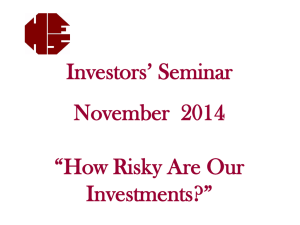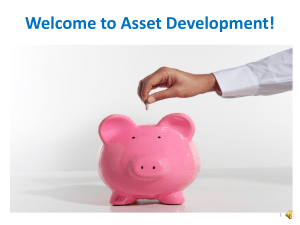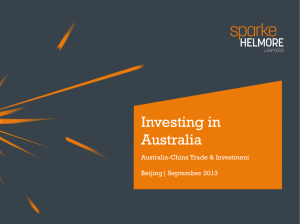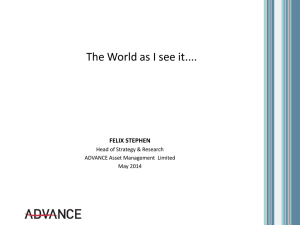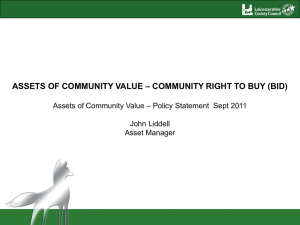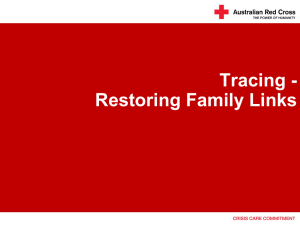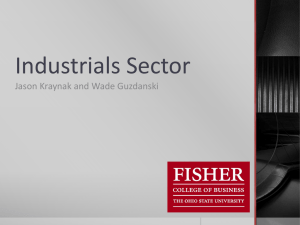HaydenFS.Seminar.September.2011
advertisement
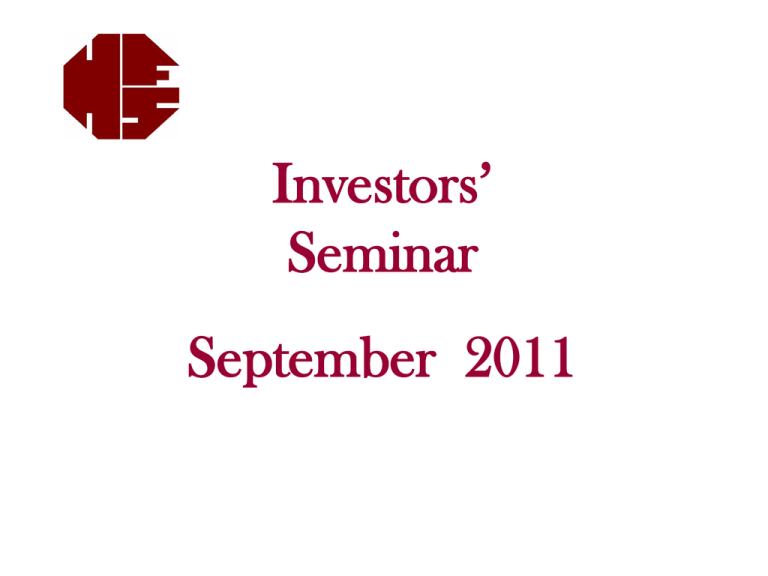
Investors’ Seminar September 2011 Disclaimer This is not Advice. Please see Mark before considering any changes. Mark will put any recommendations in writing The information contained in this presentation has been prepared for general use only and does not take into account your personal investment objectives, financial situation or particular needs. Before you make any decision about whether to invest in a financial product, you should obtain and consider the Product Disclosure Statement of the financial product. The information provided by HFS has been done so in good faith and has been derived from sources believed to be accurate at the time of compilation. Changes in circumstances, including unlawful interference and unauthorised tampering, after the date of publication may impact on the accuracy of the information. Neither HFS d nor any member of HFS accepts responsibility for any inaccuracy or for investment decisions or any other actions taken by any person on the basis of the information included. Past performance is not a reliable indicator of future performance. Neither HFS nor any member of HFS guarantees the performance of the Funds, the repayment of capital or any particular rate of return. The performance of any unit trust depends on the performance of its underlying investment which can fall as well as rise and can result in both capital losses and gains. Consequently, due to market influences, no assurance can be given that all stated objectives will be achieved. Investors’ Seminar September 2011 Will I achieve my goals? Will we achieve our goals? The Boxes to Tick Realistic Goals Structure/Strategy (Tax etc) Super Fund Admin Asset Mix 1 -Cash/TermDs needed Asset Mix 2–Growth Section (LHS) Stock-Picker Selection Non – investment Matters 1. Goals – realistic cashflow needs 2. Structure & Strategy Super & Pensions Tax & Centrelink Matters 3. Super Fund Admin SMSFs vs Wholesale/Retail/Industry etc Investors’ Seminar September 2011 The Current Environment Governments have high debt levels Governments have the financial burden of dealing with aging populations (ie pension liabilities) Globally the Stimulus Funds have not been spent on productive assets or infrastructure Households over-leveraged from years of easy credit sourced from rising house prices The Current Drivers Fear prevails – affecting both the Market and the Economy Consumers are restrained – becoming net savers Inflation vs deflation – less topical now Investors’ Seminar September 2011 Historical Data Forecasts Hayden Asset Allocation Model Specific Investment Selection Bad case scenarios Investors’ Seminar September 2011 Historical Data How far back to go? Is old “data” relevant in today’s world? Predictive Data Theory; Reasoned Rational Approach Historical Data Lonsec Asset Classes - Historical Characteristics to 30 June 2011 Returns (%p.a.) Australian Equities Global Equities Australian Fixed Interest % pa Cash % pa Australian Listed Property % pa % pa 5 years 2.4 -4.6 -10.3 6.5 5.6 10 years 7.2 -3.2 2.1 6.2 5.4 15 years 9.2 3.5 6.0 7.1 5.5 20 years 10.0 5.6 6.9 8.0 5.9 % pa Probability of a Negative 12 month Return Probability (%) Australian Equities Global Equities Australian Listed Property Australian Fixed Interest Cash 19 34 17 2 0 Return Return on on Investment Investment of of $100,000 $100,000 December December 1979-2010 1979-2010 $80 $80 1800 1800 1600 1600 $60 $60 1400 1400 $50 $50 1200 1200 Capital tal Valu Valuee (000’s (000’s)) Capi Income (000’s) (000’s) Income $70 $70 1000 1000 $40 $40 800 800 $30 $30 600 600 $20 $20 400 400 $10 $10 200 200 $0 $0 00 80 80 82 82 84 84 86 86 88 88 90 90 92 92 94 94 96 96 98 98 Industrials Industrials --Dividends Dividends Industrials Industrials --Capital Capital Value Value Source: Source: MLC MLC Data: Data:Industrials Industrials represented represented by byS&P/ASX S&P/ASX200 200 Industrials Industrials Price Price Index Index(All (All Industrials IndustrialsPrice PriceIndex Index used used prior prior to to April April2000) 2000) 00 22 44 66 Term TermDeposits Deposits -- Interest Interest Term TermDeposits Deposits -- Capital Capital Value Value 88 10 10 Yield Yield of of Investments Investments from from December December 1979-2010 1979-2010 20% 20% 18% 18% 16% 16% 14% 14% 12% 12% 10% 10% 8% 8% 6% 6% 4% 4% 2% 2% 0% 0% 80 80 82 82 84 84 86 86 88 88 90 90 92 92 94 94 96 96 98 98 00 22 44 66 88 10 10 Year YearEnded Ended31 31December December Industrials IndustrialsIndex Index --Spot SpotYield Yield Source: Source: MLC MLC Data: Data:Industrials Industrialsrepresented representedby byS&P/ASX S&P/ASX200 200Industrials IndustrialsAccum AccumIndex Index(All (All Industrials IndustrialsAccum AccumIndex Indexused usedprior priorto toApril April2000) 2000) Term TermDeposits Deposits --Spot SpotYield Yield Accumulation Accumulation Indices Indices Value Value of of $100,000 $100,000 invested invested December 1979 -2010 -2010 $7,000,000 $7,000,000 $6,000,000 $6,000,000 Industrials Industrials$5,494,998 $5,494,998 4.4 times 4.4 times $5,000,000 $5,000,000 $4,000,000 $4,000,000 $3,000,000 $3,000,000 $2,000,000 $2,000,000 $1,000,000 $1,000,000 All AllOrds Ords $3,433,928 $3,433,928 3.6 3.6times times Resources Resources$2,915,472 $2,915,472 2.4 2.4times times $0 $0 79 79 81 81 83 83 85 85 87 87 89 89 91 91 93 93 95 95 97 97 99 99 01 01 03 03 05 05 07 07 09 09 Source: Source: MLC MLC Australian long term returns Average annual total returns after inflation 19002007 % 19502007 % Real bond returns 1.3 0.6 -6.3 0.9 -5.1 2.1 10.1 3.1 Real equity total returns 7.9 6.9 9.0 10.6 -4.2 8.6 9.0 10.2 Real equity capital gains 2.0 1.5 2.4 4.6 -10.6 4.0 4.6 6.1 5.9 5.4 6.6 6.0 6.4 2.6 4.4 4.1 1950s 1960s 1970s 1980s 1990s % % % % % 20002007 % Income compounding effect Source: ABN AMRO / London Business School : ‘Global Investment Returns Yearbook 2008’ Past performance is not a reliable indicator of future performance. Forecasts Lonsec – August 2011 Asset Class 10 Year Forecasts Asset Class Yield % pa Growth % pa Total % pa Australian Equities 4.0 6.0 10.0 Global Equities 2.5 7.0 9.5 Australian Listed Property 6.0 2.5 8.5 Australian Fixed Interest 6.0 0 6.0 Cash 5.5 0 5.5 CPI 2.8 Wages Price Data 3.9 Investors’ Seminar September 2011 Historical Data Forecasts Hayden Asset Allocation Model Specific Investment Selection Bad case scenarios Hayden Asset Allocation Model Australian Shares Term Deposits International Shares Property?? Cash The Hayden Asset Allocation Model Segmentation Bar RHS – Cash and Term Deposits LHS – 10+ Year Focus Never need to address the best investment for say 2 to 8 years. Never need to predict the return of Growth assets over the short-term. We do need dividends etc to replenish the RHS – but regularity is not relevant. It can be zero for 1 or 2 years (most unlikely because the businesses will not exist if they do not make profits). Asset Mix - Decision 1 The Segmentation Bar – ie vertical bar that segregates the short-term RHS and the LHS RHS - Return of the $ invested at the designated time; has a 0-2 year focus. CashFlow Needs are the main determinator. Cash and Term Deposits - this section is structured to be “Consumed” Asset Mix - Decision 2 The LHS Side of the Bucket. The Goals are: Main Goal - Long-Term Total Returns – 10 Year Targets Sub Goal – replenish the Cash Volatile Returns are not a concern Income is not a focus – maximising returns is the goal. A business that reinvests is not any less attractive than one that pays out all profit as a dividend. Projections What are the key timeframes: 0-2 years – no projections needed. Cash and Term Deposits cover all goals in this time frame 2-8 years – not necessary to invest in this timeframe if we can have a 10 year focus which incorporates better returns 10+ years – the key goals. Again we use the Tim Farrelly Projections Hayden Asset Allocation Model – Growth (LHS) AS IS P TD Cash Specific Investments for the LHS Australian/International Shares We have a 10 year plus time frame so we are sharing in the profits generated by the business – ie either dividends and/or capital growth generated by higher profits We want a good portfolio and we want it monitored and changed when needed Best way - contract Specialist Stock-pickers Drilling down further AS IS P TD Cash XYZ Manager Is a Stock-Picker Needed? The three choices: 1. Index Funds …* 2. Choose Your Own Stocks …# 3. Contract a High-Quality Stock-Picker * 3 is preferred because some businesses better than others- ie either in a better Industry and/or better Management. # 3 is preferred because some people have specialised skills and resources in finding and then analysing businesses? It is worthwhile contracting these skills. Choosing a Stock-Picker A quality stock-picker is contracted for Their selected portfolio of shares and Their skills in monitoring and changing that portfolio For each underlying investments we can ask them why they part-own that business and what are the key factors that would lead them to sell that business The investee businesses must either have High Profit Margins or High Turnover and Reasonable Profit Margins. And this advantage must be sustainable. Specific Investments We, via the Specialist Stock-pickers, want : ** the best performing businesses over a 10+ year time frame We want to buy these on the stock-market Most stock-market participants are looking for the best 1 year performers. Their time frame may be shorter, eg 3 months,or……even intra-day! This can be to our advantage. Avoid the noise. How Many Managers -ie stock-pickers? Obtain diversification – ie different processes and different people/perspectives Not too many that we dilute the best performers Around 3-5 in both Australian and International Shares The Buffett Overlay The businesses that we part-own (via our specialist Fund Managers) should, or must, meet these criteria: We want to select Good Businesses – ie those with a Durable Competitive Advantage We want to avoid Poor Businesses - ie those where price is the major motivating factor in the consumer’s decision to buy their product or service. Best & worst performing companies S&P/ASX 100 for the year ended 31 July 2011 Best stocks % Worst stocks % Iluka Resources 222.91 BlueScope Steel Limited -51.90 Lynas Corporation 182.89 Seven West Media Ltd -48.27 Atlas Iron Limited 101.49 OneSteel Limited -40.97 Fortescue Metals Group 47.09 Fairfax Media Limited -40.34 PanAust Limited 43.86 Harvey Norman -37.71 Alumina Limited 40.65 David Jones Limited -37.50 Challenger Limited 38.92 Billabong -35.42 Charter Hall Office 35.51 Myer Holdings Limited -33.04 ConnectEast Group 32.50 Goodman Fielder -32.58 Boart Longyear 32.35 Paladin Energy Limited -31.95 Average 77.82 Average -38.97 Top 100 companies by market capitalisation % returns for the year ended 31 July 2011. Source: IRESS. Past performance is no indication of future performance. Australian equities have a significant sector bias vs global equities… [8] Sector weights as at 30 June 2010 100% 90% 80% 70% 60% 50% 40% 30% 20% 10% 0% S&P/ASX200 Materials Energy Source: Bloomberg Financials S&P 500 Consumer Discretionary & Staples S&P Global 1200 Industrials & Utilities Health Care IT & Telecommunications Investors’ Seminar September 2011 Historical Data Forecasts Hayden Asset Allocation Model Specific Investment Selection Bad case scenarios Investors’ Seminar September 2011 What is our greatest fear? “running out of money” “not achieving lifestyle goals” “losing money” …..readily addressed; we need patient capital; there is no value-add by counting it daily …..need the faith to leave it; let it grow; leave it in a Bank, a Property, a Business etc Investors’ Seminar September 2011 The Fear: Not achieving our goals (including running out of money) What’s needed: The “tap” turned on at a reasonable rate Reasonable long-term returns Bad case scenarios: Share Prices “crash”; Dividends reduce; Cash and Term Deposit Rates are very low Investors’ Seminar Bad Scenarios Cash and Term Deposit Rates are very low – not a concern – liquidity and security the RHS’ focus Dividends reduce – zero for one year is no concern; Some businesses will survive (ie some employment) hence some Earnings Share Prices “crash”- What part is “noise” – relatively minor and what part is “fundamental” – changing the economy. Good Businesses will still generate Earnings. This will show partly as Dividends; partly in increased future Dividends; and partly an increased intrinsic value of the Business. Illustrating the Bad Case Scenarios Cash and Term Deposit Rates - zero Dividends reduce – NB Still will be some dividends (ie any surviving business will pay dividends most years) Share Prices “crash”- The LHS will never be zero – there will always be some businesses Asset Mix Australian Shares Term Deposits International Shares Property?? Cash Specialist Stock-picker AS IS P TD Cash XYZ Manager Switching Changes to Lifestyle or Financial Goals Asset Sector Changes – eg if the 10 year return differential is significant; Switching of Fund Managers – may be needed at any time if a change to skill level or portfolio integrity. In switching Managers we retain the same asset sector exposure –eg to shares. The Boxes to Tick Realistic Goals Structure/Strategy (Tax etc) Super Fund Admin Asset Mix 1 -Cash/TermDs needed Asset Mix 2–Growth Section (LHS) Stock-Picker Selection Peace-of-mind for Investors 1. Part-own a lot of great businesses. We have a portfolio of businesses that is well diversified across locations, industries and size. 2. Employing (contracting) some very wise people to monitor and change our portfolio of investee businesses when necessary.
